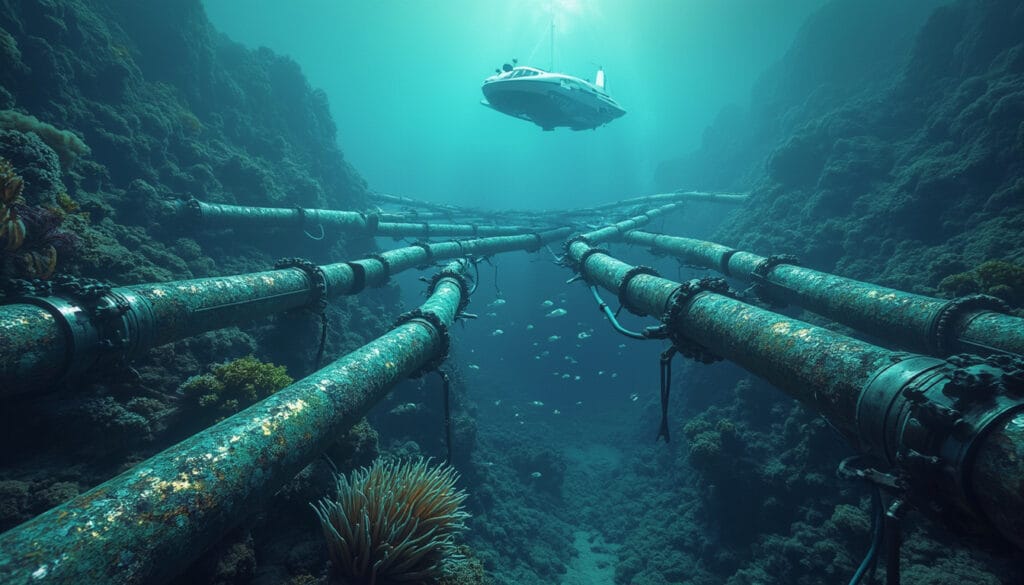Environmental Impact of Marine Energy
Assessing the environmental impact of marine energy is essential to determine their viability. Devices such as tidal turbines and wave energy plants generally have a lower ecological footprint than fossil fuels.
However, installing marine infrastructures can affect marine ecosystems. Underwater habitats can be altered, impacting local wildlife. Detailed studies are necessary to minimize these impacts.
Here are some measures to reduce negative effects:
– Use eco-friendly materials.
– Establish protection zones around installations.
– Encourage the integration of artificial habitats to promote biodiversity.
The environmental benefits are numerous; marine energy production reduces CO2 emissions and dependence on fossil fuels. When carried out responsibly, it offers a sustainable solution for the overall energy transition.
Effects on Marine Ecosystems
Marine energy represents a significant untapped potential in the field of renewable energies. It includes various technologies such as tidal energy, marine currents, waves, and ocean thermal conversion. These technologies allow us to harness the vast resources of the oceans to generate electricity sustainably.
Environmental impact of marine energy
Marine energy presents several environmental advantages. Unlike fossil fuels, it does not generate greenhouse gases or air pollutants. Furthermore, marine installations often occupy less space compared to onshore wind farms or solar farms, which helps to reduce the impact on terrestrial habitats and surrounding ecosystems.
However, it is essential to consider potential impacts on marine ecosystems. Devices installed at sea can interfere with the migratory routes of fish and marine mammals, as well as with benthic habitats. To minimize these impacts, rigorous environmental studies are necessary before the implementation of new marine technologies.
Effects on Marine Ecosystems
Marine installations can affect biodiversity in several ways. For example, underwater structures can create new habitats for certain species but disrupt others. The vibrations and noise generated by these devices can also disturb sensitive species like cetaceans and fish.
To protect marine ecosystems, it is crucial to implement mitigation measures. This may include the use of non-toxic materials, the establishment of marine protected areas, and ongoing monitoring of local marine populations. It is also possible to design systems that minimize acoustic disturbances.
Marine technologies offer a path towards cleaner and more sustainable energy. However, careful balance is needed to ensure that these solutions do not compromise the health of marine ecosystems, which are vital for biodiversity and human communities dependent on the oceans. By adopting responsible approaches, it is possible to maximize benefits while minimizing negative impacts.
Reducing Greenhouse Gas Emissions
Marine energy represents a tremendous opportunity to diversify our energy mix and reduce our dependence on fossil fuels. Still underutilized, it leverages the natural resources offered by the oceans: tides, waves, currents, and thermal gradients. By integrating these technologies, we can produce clean and sustainable electricity.
The environmental impacts of marine energy are often less than those of traditional energy sources. Marine energy devices, such as hydrokinetic turbines and wave energy buoys, are designed to operate harmoniously with the marine ecosystem. Unlike land-based installations, they often require less space and integrate more easily into the marine environment.
One of the main advantages of marine energy is the reduction of greenhouse gas emissions. By generating electricity without burning fossil fuels, these technologies actively contribute to lowering CO2 emissions, the primary gas responsible for climate change. Here are some benefits:
- Reduction of air pollution: Marine technologies emit no fine particles or nitrogen dioxide.
- Preservation of biodiversity: Marine installations are designed to minimize disturbances to marine habitats.
- Utilization of marine spaces: These projects allow for the valorization of often underused zones.
Technological innovations in marine energy offer promising prospects. With continued investment in research and development, it is possible to further improve the efficiency of systems and reduce operational costs, making this energy source increasingly competitive.
“`
Articles similaires
Thank you!
We will contact you soon.














